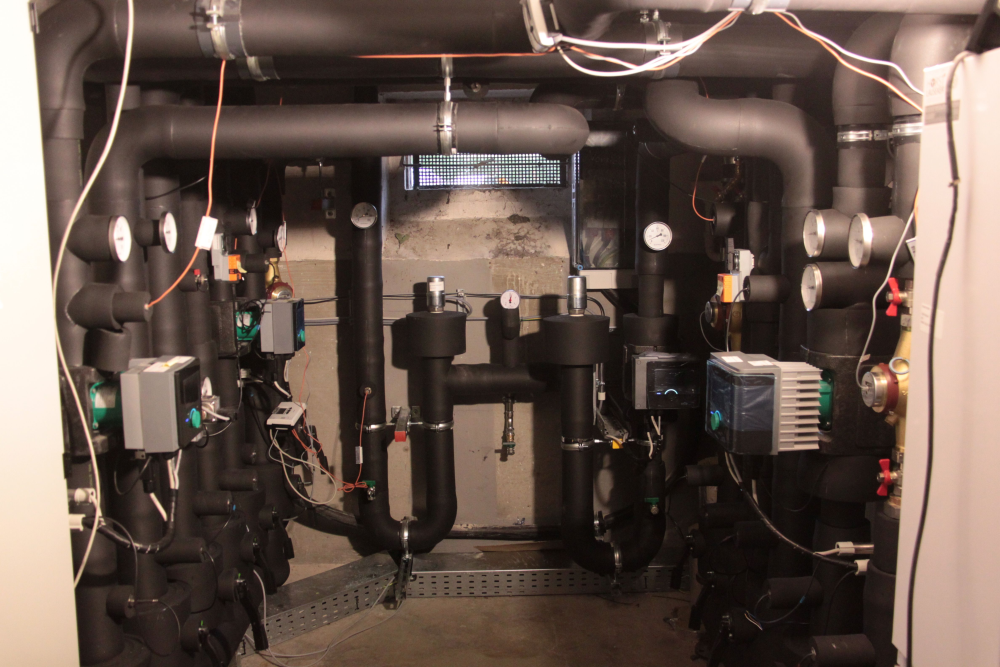| Duration: | 01/2018 - 12/2023 |
| Contracting Authority/ Sponsors: |
Federal Ministry of Economic Affairs and Climate Action (BMWK), Projektträger Jülich (PTJ) |
| Project Partners: | Viessmann Werke Allendorf GmbH |
| Website: | LowEx-Bestand |
| Project Focus: |
HEAVEN – LowEx Concepts for the Heat Supply of Existing Multi-Family Buildings (LowEx Stock)
Modulating Brine Heat Pump with Multiple-Source System and Decentralized Ventilation Equipment



In the HEAVEN sub-project of the LowEx-Bestand project network, heat sources for heat pumps in multi-family houses in urban environments with few usable surrounding areas were addressed. The combined use of outdoor air and ground heat sources was developed and investigated. Decentralized domestic ventilation systems, which can play a key role in the refurbishment of apartment buildings, were also investigated. Demand-controlled regulation in particular promises considerable energy saving potential. The control of these devices was therefore optimized and an evaluation method developed. The demands on the appliances in terms of their compactness, heat recovery and noise levels are constantly increasing, and the technical properties of a coaxial heat exchanger address these.
Modulating brine heat pump with multi-source system
A multi-source heat pump system with near-surface geothermal energy and outside air was developed as part of the HEAVEN project. The resulting functional model, which focuses on innovative heat source hydraulics and control, contributes to overcoming the heat source-related obstacles for heat pumps in multi-family housing stock and in the context of high building density. By using the two established heat sources, a significant reduction in the geothermal probe field and at the same time noise-sensitive operation of the outside air heat source is possible. Furthermore, the heat exchange between the sources offers advantages in that the ground can be regenerated by warm outside air in summer and the ground can be used as a low-temperature heat source for defrosting the air-heat exchanger in winter.
Optimization and evaluation of home ventilation with pendulum fans
Optimized control strategies were developed for decentralized ventilation units on the basis of a specially created model. With the help of a test stand designed for device development, the purge air method was further developed for the energetic evaluation of decentralized ventilation devices. Among other things, this enabled enthalpic balancing to be realized. By working together, the ventilation effectiveness of the devices could be determined on the basis of measurements in real buildings and taken into account for the energy assessment. The user-centered control development for these decentralized ventilation units was also carried out as part of the field measurements.
Decentralized ventilation unit with coaxial heat exchanger and energy-efficient axial fans
Based on the mathematical description of the geometry of the coaxial heat exchanger, multiphysical simulations were carried out for the first time for this concept, taking this complex heat exchanger geometry into account. The geometry was converted into a CAD model and an initial test sample was produced in real size using 3D printing. The flexibility achieved in this way made it possible to consider variations in the geometry with regard to the number of channels and the length of the inflow and central heat exchanger areas.


More Information on this Topic:
- Dissertation: Metz,J. – »Entwicklung und experimentelle Analyse eines Mehrquellen-Wärmepumpensystems aus Erdreich und Außenluft« (publica.fraunhofer.de)
- Dissertation: Carbonare, N. – »Occupant-centered control strategies for decentralized residential ventilation«
- Dissertation: Auerswald, S. – »Dezentrale Fassaden-Integrierte Wohnungslüftungsgeräte« (publica.fraunhofer.de)
- Science and Technology for the Built Environment: Carbonare, N.; Pflug, T.; Bongs, C.; Wagner, A. – »Simulative study of a novel fuzzy demand controlled ventilation for façade-integrated decentralized systems in renovated residential buildings«
- Energies: Carbonare, N.; Fugmann, H.; Asadov, N.; Pflug, T.; Schnabel, L.; Bongs, C. – »Simulation and Measurement of Energetic Performance in Decentralized Regenerative Ventilation Systems«
- IOP Conference Series: Carbonare, N.; Pflug, T.; Bongs, C.; Wagner, A. – »Comfort-oriented control strategies for decentralized ventilation using co-simulation«
- 39th AIVC Conference: Auerswald, S.; Carbonare, N.; Pflug, T.; Bongs, C.; Engelmann, P.; Henning, H. – »A holistic evaluation method for decentralized ventilation systems«
- 7. Deutsch-Österreichische IBPSA-Konferenz: Carbonare, N.; Pflug, T; Wagner, A. – »Clustering the Occupant Behavior in Residential Buildings: a Method Comparison«
- 38th AIVC Conference: Carbonare, N.; Coydon, F.; Dinkel, A.; Bongs, C. – »The influence of occupancy behaviour on the performance of mechanical ventilation systems regarding energy consumption and IAQ«
- Energy and Buildings: Carbonare, N.; Pflug, T.; Maier, D.; Auerswald, S.; Berneiser, J. – »Feeling the breeze? Ventilation practices and occupant requirements for mechanical ventilation in residential buildings«
- Conference Indoor Environmental Quality Performance Approaches: Auerswald, S.; Devineni, R.; Pflug, T.; Bongs, C. – »Ventilation Effectiveness Of Alternating Façade-integrated Ventilation Devices in a Dwelling« (publica.fraunhofer.de)
- Energies: Auerswald, S.; Hörberg, C.;.; Pflug, T; Pfafferott, J.; Bongs, C.; Henning, H. – »Experimental Investigation of the Air Exchange Effectiveness of Push-Pull Ventilation Devices«
- Auerswald, S.; Devineni, R.; Bavia Bampi, B.; Pflug, T.; Bongs, C.: »Charakterisierung von Lüftungseffektivität und thermischer Effizienz von Pendellüftern«: DKV-Tagung 2021. AA IV 96. In: Deutsche Kälte- und Klimatagung 2021 Dresden. Proceedings of the Deutsche Kälte- und Klimatagung, Dresden, Deutschland, 2021/11/17 - 2021/11/19; DKV e.V. (publica.fraunhofer.de)